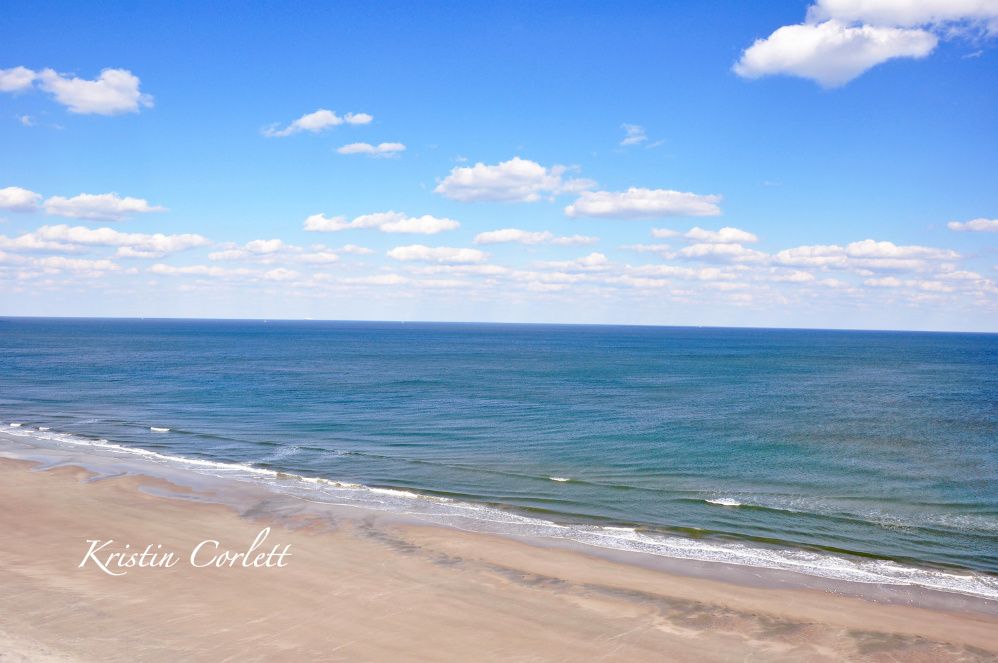The photo of the day this morning was causing a ruckus! Well, I found another photo that I took of the beach and ocean. Click to enlarge the photo above to really see the sand and waves. The dry sand is at the bottom of the frame and it's blowing across the wet sand toward the water. It was really windy this particular day - wind gusts in the 50 mph range - but a constant wind at about 30mph for most of the day.
You can see the ripples in the water from the wind, too. They are indeed moving the water in the opposite direction - so probably that's why there were no waves. They were literally blown away!
Below is the POTD from this morning and the three comments that had a life of its own! I hope I got the questions answered about the wind and the waves.
Oh and to answer Ann's question (below). Yes, you can smell the ocean as you get closer to it. I noticed it more in Daytona Beach than I do here in Jacksonville, but that's probably because I worked down by the ocean when I lived in Daytona. The humidity is different, the wind is stronger, and it smells like shells. Smelling like shells in the way I describe the fishy, salty, seaweed ocean smell. If i bring shells home from the beach, they have that smell - fishy, salty, seaweedy, ocean smell. That's the best I can describe it. I live about 15 miles from the ocean and I can't smell it all from here.
 Caution Flag said...
Caution Flag said...- I am so ocean ignorant. I thought wind = waves. Maybe I need to do some first hand research.

 Keetha Denise Broyles said...
Keetha Denise Broyles said...- Nope Caution Flag, you are not mistaken about wind and waves! This is very interesting Miss Kristin! Wave height = speed of wind x distance traveled over water x length of time wind blows. So - - - I'm scratching my BRAIN trying to figure why there were no waves. Had the wind JUST started? OR - - - was it a LAND breeze, which was blowing from the land TOWARD the water - - - that would mean the waves were being pushed out to sea. You have given us QUITE a conundrum this morning!

 Ann in the UP said...
Ann in the UP said...- I was puzzled too. But I guess it makes sense that wind direction would make a difference in the wave height. Ask Dr. Science! BTW, can any of you detect the ocean by the smell of the air on the shore? I keep reading that people do that, but I guess I'm olfactory-impaired.
Thanks everyone! Have a great day!
Kristin



4 comments:
That's the ANSWER then!!!
Wind blowing from the land toward the water is called a "land breeze." It actually pushes the surface of the water AWAY from the shore - - - thus the waves are also being pushed the other way.
Land breezes form when the water is warmer than the surface of the land. Air takes on the properties of the surface over which it is sitting. So the air over the water is WARM and rises. The air over the cooler land is cooled, therefore COLD and dense and it rushes out to take the place of the warm air that rose over the see.
Voila! A land breeze pushing the surface of the water out to sea!
GREAT Earth Science visual aid, Miss Kristin!!!!
(Oh - - - those lovely breezes that we all EXPECT at the sea, the ones that flow from the water onto the shore - - - those are called SEA Breezes and the exact opposite conditions cause them - - - land surface warmer than the water.
I just got smarter :) And apparently I had the wrong understanding of what a land breeze is. Is a land breeze unusual, Keetha? I would think it is simply because we so rarely see a flat ocean. Then again, maybe it looks too much like a lake and not many people stop to take a picture ??
That sand is really blowing and you can see the ripples in the ocean. Pretty strong winds!!!
The general trend is for Sea Breezes to blow during the day when the sun warms the land to a much higher temperature than the water, due to the fact that it takes far more energy to warm water than land.
Then at night, the ocean water holds its warmth and if the land cools below the temperature of the water, then the land breeze begins.
What is probably unusual is a land breeze so strong that it pushes the waves back like in Kristin's photo.
Post a Comment